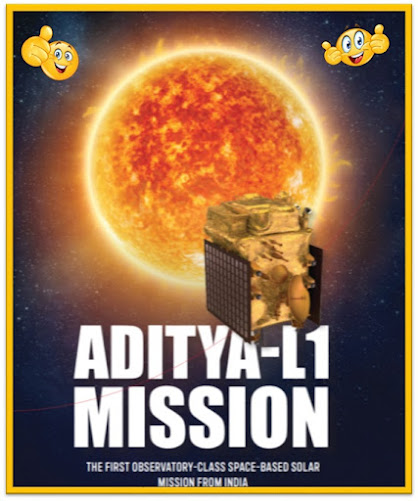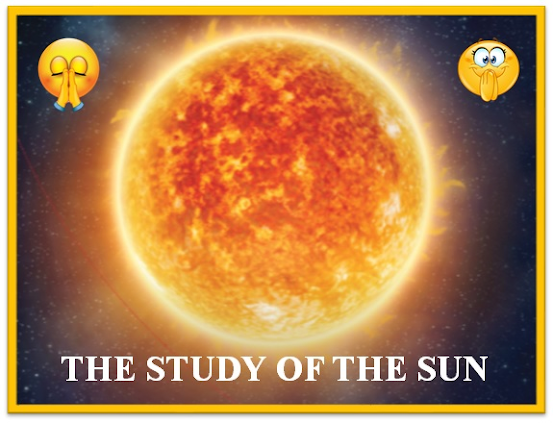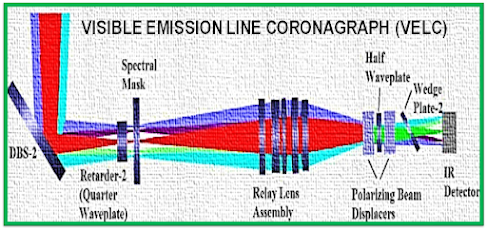Aditya L1
Aditya L1 India's milestone in the study of the Sun
Our
Sun is the closest star and the largest body in the Solar System. The Sun is a
giant ball of hot plasma, which is a state of matter where the electrons are
stripped from the atoms. The plasma in the Sun is so hot that it glows with a
bright light. The distance from the Earth to the Sun is approximately 150
million kilometers and is the source of energy for our solar system. We know
that life on Earth is not possible without solar energy does not exist. The
Sun's gravity is the force that keeps the planets, asteroids, comets, and other
objects in their orbits. The temperature in the central region of the Sun,
known as the 'core', can reach 15 million degrees Celsius. At this temperature,
a process called nuclear fusion takes place in the core that powers the Sun. The
photosphere, the visible surface of the Sun, is a thin layer of hot plasma with
a temperature of about 5,500°C.
Why study the Sun?
The
Sun is the closest star and can therefore be studied in more detail than other
stars. By studying the Sun, we can learn a lot about the stars in our own
galaxy, as well as about stars in various other galaxies.
The
Sun is a highly mobile star that stretches far beyond what we can see. It
exhibits many explosive events and releases enormous amounts of energy into the
solar system. If such an explosive solar event is directed toward Earth, it can
cause various disturbances in the near-Earth space environment.
Various
spacecraft and communication systems are susceptible to such disturbances and
therefore it is important to take early warning of such incidents and take
corrective measures well in advance. Besides, an astronaut is at risk if he is
directly exposed to such explosive events. These phenomena can be very extreme,
with temperatures reaching millions of degrees Celsius and magnetic fields
billions of times stronger than Earth's. Thus, the Sun also provides a good
natural laboratory for understanding phenomena that cannot be studied directly
in the laboratory.
Studying Space Weather of the Sun
The
Sun continuously impacts the Earth with radiation, heat particles, and a
magnetic field. The constant stream of particles from the Sun is known as the
solar wind and is mainly composed of high-energy protons. The solar wind fills
almost all of the space in the known solar system. Solar wind as well as solar
magnetic field. Also, fill the solar system. The solar wind, along with other
explosive/explosive solar events such as coronal mass ejections (CMEs), affects
the shape of space. During such events.
The
magnetic field and charged particles near the planet change the nature of the
atmosphere. In the case of Earth, the interaction of the Earth's magnetic field
with the field brought about by the CME can cause near-Earth magnetic
disturbances. Such incidents may affect the operation of the property.
Space
climate refers to the changing environmental conditions in space around Earth
and other planets. We use more and more technology in space because
understanding space weather is so important. Also, understanding near-Earth
space weather sheds light on the behavior of space weather on other planets.
About Aditya-L1
Aditya
L1 will be a pioneering Indian mission to study the Sun from a unique vantage
point in space. It will be placed in a halo orbit around the L1 Lagrange point,
where the gravitational forces of the Sun and Earth are balanced. A satellite
placed in a coronal orbit around the L1 point has the great advantage of
continuously observing the Sun without any eclipse/eclipse. This will provide
the added benefit of monitoring solar activity and its impact on space weather
in real-time. The spacecraft carries seven payloads to observe the photosphere,
chromosphere, and the Sun's outermost layers (corona) using electromagnetic particle and magnetic field detectors. Using a special vantage point L1, four
payloads directly observe the Sun, and the remaining three payloads conduct
in-situ studies of particles and fields at Lagrange point L1, thus providing an
important scientific study of the propagation effects of solar dynamics in the
interplanetary medium. It is expected that the set of Aditya L1 payloads will
provide the most important information for understanding coronal heating,
coronal mass ejection, pre-flare and flare activity and their characteristics,
space weather dynamics, particle and field diffusion, etc.
The
Aditya L1 mission will study other aspects of the Sun, such as its photosphere,
chromosphere, magnetosphere, and solar activity. The seven instruments on Aditya
L1 will be a powerful tool for understanding the Sun and its impact on Earth:
1. Visible Emission Line Coronagraph (VELC):
This device will create an artificial eclipse of the Sun by blocking the bright disk of the Sun and allowing only the faint corona to be seen. It will measure the intensity and polarization of coronal emission lines and provide images and spectra of the corona.2. Solar Ultraviolet Imaging Telescope (SUIT):
This instrument will capture images of the Sun in different wavelengths of ultraviolet light. The composition and dynamics of the photosphere and chromosphere, the lower layer of the Sun's atmosphere, will be studied.3. Solar Low Energy X-ray Spectrometer (SoLEXS):
This instrument will measure the intensity and spectrum of soft X-rays emitted by the Sun. It will observe variations in the solar X-ray flux and study the heating mechanism of the corona.4. High Energy L1 Orbiting X-ray Spectrometer (HEL1OS):
This instrument will measure the intensity and spectrum of hard X-rays emitted by the Sun. It will detect solar flares and other energetic phenomena on the Sun's surface.5. Aditya Solar Wind Particle Experiment (ASPEX):
This instrument will analyze the composition and direction of solar wind particles like protons and heavy ions. How the solar wind affects the atmosphere in space around Earth will be studied.6. Plasma Analyser Package for Aditya (PAPA):
This instrument will measure the temperature, density, and velocity of electrons in the solar wind. How the solar wind interacts with the interplanetary magnetic fields will also be studied.7. Advanced Tri-Axis High-Resolution Digital Magnetometer:
This device will measure the strength and direction of the magnetic field in three dimensions. This will help in understanding how the magnetic field affects the solar wind and corona.The Aditya-L1 mission will address the most fundamental questions:
1.
Study of dynamics of solar upper atmosphere (chromosphere and corona).
2.
Study of chromospheric and coronal heating, physics of partially ionized
plasma, coronal mass ejections, and initiation of flares.
3.
Observe in-situ particle and plasma environments providing data for studies of
particle dynamics from the Sun.
4.
The heating mechanism of the solar corona and a major unsolved problem in solar
physics.
5.
Diagnosis of Coronal and Coronal Loop Plasma: Temperature, Velocity and
Density.
6.
Evolution, dynamics, and origin of CMEs.
7.
Identify the sequence of processes occurring at several levels (chromosphere,
base, and extended corona) that ultimately lead to solar flare events.
8.
The magnetic field of the solar corona is a complex and dynamic system, and its
topology is still not fully understood.
9.
The solar wind is a key player in space weather, and understanding its origin,
composition, and dynamics is essential for predicting and mitigating its
effects.
Why study the sun from space?
The
Sun emits radiation/light at almost all wavelengths, including various
energetic particles and magnetic fields. Earth's atmosphere and its magnetic
field act as a protective shield and block many harmful wavelengths of
radiation, including particles and fields. Since various radiations do not
reach the Earth's surface, instruments on Earth cannot detect such radiations
and solar studies cannot be conducted based on these rays. However, such
studies can be done outside the Earth's atmosphere, i.e. by observing from
space. Similarly, to understand how solar wind particles and the Sun's magnetic
field travel through interplanetary space, measurements must be made from a
point far from the influence of Earth's magnetic field.
CONCLUSION
Aditya L1 is a bold and ambitious mission that will help India
to better understand the Sun and its impact on Earth. It will enable us to
explore the Sun and its atmosphere with unprecedented detail and precision.
This will help us protect our planet and ourselves from the harmful effects of
space weather. The Aditya L1 mission is a shining example of India's vision,
ambition, and innovation in space science and technology. It is an inspiration
for the young generation of Indians to pursue their dreams and aspirations in
science and engineering. The Aditya L1 mission is not only a journey to the Sun
but also a journey to the future.




















No comments:
Post a Comment
If you have any doubts, please let me know